List of Australian Football League grounds
The Australian Football League has numerous grounds upon which senior VFL/AFL games have been played. This list comprises current grounds in use, former grounds in use (both major and minor), regional pre-season grounds and international grounds.

In accordance with the Laws of Australian football, a ground must be grassed, have a minimum length of 135 metres (443 ft) and a minimum width of 110 metres (360 ft).[1] Most Australian rules football grounds are also used for cricket, which is also played on a grassed, oval-shaped ground, and it is commonplace for a ground to be used for football in winter and cricket in summer.
Due to the popularity of Australian rules football, particularly in southern Australia, most of Australia's largest stadiums by capacity are used for Australian rules football; and it is therefore common to use those stadiums for other high-drawing events, particularly sporting events. Sports such as rugby and soccer can be readily played on an Australian rules football arena, as their rectangular fields are small enough to be set on the larger oval.
The oldest Australian Football League ground is the Melbourne Cricket Ground. The ground was built in 1854 and is still used for hosting AFL matches, including each year's Grand Final. The ground also has the largest capacity, at 100,024. The ground to be used most recently for its first Australian Football League matches is Mars Stadium in Ballarat, Victoria, on 19 August 2017.
As of the end of 2017, a total of 46 different venues have hosted VFL/AFL premiership matches since the league was established in 1897.
AFL/VFL premiership season venues
Current grounds
The following table shows a list of all of grounds that are currently used in the Australian Football League, as of the 2017 AFL season. The table includes grounds where teams have commercial deals in place to transfer home games to these grounds each season but are not full-time tenants of those grounds; in these cases, the club is shown in italics in the current tenants column.
| Ground | Image | Other/sponsored names | City | State/territory | Capacity | First used | Current tenant(s) |
|---|---|---|---|---|---|---|---|
| Melbourne Cricket Ground |  |
MCG
The 'G |
Melbourne | Victoria | 100,024[2] | 1897 | Collingwood Hawthorn Melbourne RichmondEssendon |
| Perth Stadium |  |
Optus Stadium (2018–present) | Perth | Western Australia | 60,000[3] | 2018 | West Coast Fremantle |
| Docklands Stadium |  |
Colonial Stadium (2000–2002) Telstra Dome (2003–2008) Etihad Stadium (2009-2018) Marvel Stadium (2018–present) |
Melbourne | Victoria | 56,347[4] | 2000 | Essendon North Melbourne St Kilda Western Bulldogs Carlton |
| Adelaide Oval |  |
Adelaide | South Australia | 53,583[5] | 2011[n 1] | Adelaide Port Adelaide | |
| Sydney Cricket Ground | 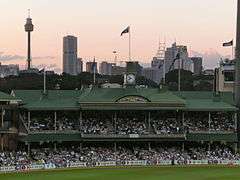 |
SCG | Sydney | New South Wales | 48,000[6] | 1903[7] | Sydney |
| The Gabba | 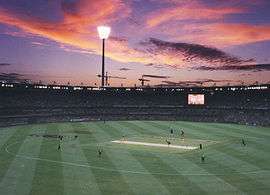 |
Brisbane Cricket Ground BCG |
Brisbane | Queensland | 42,000[8] | 1991 | Brisbane |
| Kardinia Park |  |
Shell Stadium (1999–2001) Baytec Stadium (2002 pre-season) Skilled Stadium (2002–2011) Simonds Stadium (2012–2017) GMHBA Stadium (2017–present)[9] |
Geelong | Victoria | 36,000[10] | 1941 | Geelong |
| Carrara Stadium | 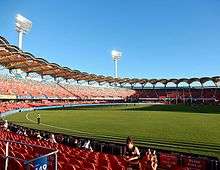 |
Metricon Stadium (2011–present) | Gold Coast | Queensland | 25,000[n 2][11] | 1987 | Gold Coast |
| Sydney Showground Stadium | Škoda Stadium (2012–2013) Spotless Stadium (2014–2018) GIANTS Stadium (2019–present)[12] |
Sydney | New South Wales | 25,000 | 2012 | Greater Western Sydney[13] | |
| York Park |  |
Aurora Stadium (2004–2016) University of Tasmania Stadium (2017–present) |
Launceston | Tasmania | 20,000[14] | 2001 | Hawthorn[n 3] |
| Bellerive Oval | 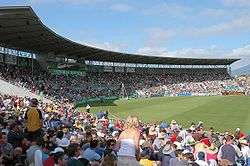 |
Blundstone Arena (2012–present) | Hobart | Tasmania | 20,000 | 2012 | North Melbourne[n 3][13] |
| Manuka Oval | StarTrack Oval Canberra (2013-2016) UNSW Canberra Oval (2017–present) |
Canberra | ACT | 15,000[15] | 1998 | Greater Western Sydney | |
| Marrara Oval | 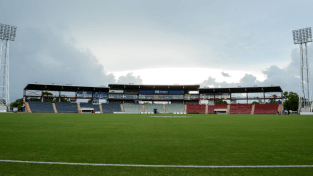 |
TIO Stadium (2006–present) | Darwin | Northern Territory | 12,000[16] | 2004 | Melbourne[n 3] |
| Eureka Stadium | Mars Stadium (2017–present) | Wendouree | Victoria | 11,000 | 2017 | Western Bulldogs[n 3] | |
| Jiangwan Stadium Chinese: 江湾体育场 |
 |
Adelaide Arena (2017–present) | Shanghai | China | 11,000 | 2017 | Port Adelaide[n 3] |
| Riverway Stadium | Tony Ireland Stadium | Townsville | Queensland | 10,000 | 2019 | ||
| Traeger Park |  |
TIO Traeger Park | Alice Springs | Northern Territory | 10,000[17] | 2014[18] | Melbourne[n 3] |
- Adelaide Oval hosted its first AFL match in round 24 of the 2011 season as a Port Adelaide home game against Melbourne. The ground was redeveloped and has hosted all Adelaide Crows and Port Adelaide Power home games from the 2014 season onwards, replacing Football Park.
- Redevelopment for the 2018 Commonwealth Games.
- The club is not a full-time tenant of the ground, but has a commercial deal in place to play home games at the venue.
Former major grounds

The following table comprises a list of former grounds that were at one stage the primary home ground for a club to play its VFL/AFL matches on.
Most of the grounds were the original home of current teams (for example, Arden Street Oval was North Melbourne's home ground) and have ceased hosting VFL/AFL matches, usually due to location and lack of capacity. Princes Park was the last of the suburban venues to see an AFL game, with the last match occurring in 2005. These grounds now usually serve as a boutique training oval and administrative base for these AFL clubs, and some are used for TAC Cup, VFL or suburban league matches.
Waverley Park (originally known as VFL Park), located in Mulgrave, Victoria was the first purpose-built stadium for VFL/AFL matches, opening in 1970. Until the 1990s, it did not serve as any team's home ground, but was instead a neutral venue to which each club shifted one or two of its home matches each year; in the 1990s, it was adopted as a home ground by Hawthorn and St Kilda. Original plans called for the grounds capacity to be 155,000, which would have made it one of the largest stadiums in the world. The venue, with its planned higher capacity, was originally to be a replacement for the Melbourne Cricket Ground as host of the VFL's Grand Final. However, in 1982/1983, when the extensions to finish the original plans were due to commence, the Government of Victoria refused to approve the plans for the stadium because the upgrade would have threatened the Melbourne Cricket Ground's right to host the Grand Final. Hence, no further development ever occurred and the capacity was set at 78,000. It was used until 1999, and was replaced by the Docklands Stadium.
Football Park, which was located in West Lakes, Adelaide, had a similar history to Waverley Park; it was purpose built for South Australian National Football League (SANFL) games and opened in 1974, replacing Adelaide Oval as the primary venue for the league. Unlike Waverley Park, it did become the venue for SANFL Grand Finals. It was the primary South Australian venue for VFL/AFL matches from 1991, when the league expanded into Adelaide, until 2013, and it was replaced by the newly refurbished Adelaide Oval. However, a NAB Challenge match was played between Port Adelaide and Adelaide at the ground in March 2015.
| Ground | Other/sponsored names | City | State | Capacity | Year First Used | Year Last Used | Tenants |
|---|---|---|---|---|---|---|---|
| Arden Street Oval | North Melbourne Recreation Reserve | North Melbourne | Victoria | 15,000[19] | 1925 | 1985 | North Melbourne |
| Brunswick Street Oval | Fitzroy Cricket Ground | North Fitzroy | Victoria | 15,000[20] | 1897 | 1966 | Fitzroy |
| Coburg City Oval | Coburg | Victoria | 25,000[21] | 1965 | 1965 | North Melbourne | |
| Corio Oval | Geelong | Victoria | ? | 1897 | 1940 | Geelong | |
| East Melbourne Cricket Ground | East Melbourne | Victoria | 10,000 | 1897 | 1921 | Essendon: 1897–1921 University: 1908–1910 | |
| Football Park | AAMI Stadium (2002–2015) | West Lakes | South Australia | 51,240[22] | 1991 | 2015[n 1] | Adelaide Port Adelaide |
| Glenferrie Oval | Hawthorn | Victoria | 10,000[23] | 1925 | 1973 | Hawthorn | |
| Junction Oval | St Kilda Cricket Ground | St Kilda | Victoria | 8,000[24] | 1897 | 1984 | St Kilda: 1897–1964 Fitzroy: 1970–1984 |
| Lake Oval | South Melbourne Cricket Ground | Albert Park | Victoria | 14,000[25] | 1897 | 1981 | South Melbourne |
| Moorabbin Oval | Moorabbin | Victoria | 27,000[26] | 1965 | 1992 | St Kilda | |
| Princes Park | Optus Oval (1994–2006) | Carlton | Victoria | 35,000[27] | 1897 | 2005 | Carlton: 1897–2005 Fitzroy: 1967–1969, 1987–1993 Hawthorn: 1974–1991 South Melbourne: 1942–1943 Western Bulldogs: 1997–1999 |
| Punt Road Oval | Richmond Cricket Ground | Richmond | Victoria | 15,000[28] | 1908 | 1964 | Richmond: 1908–1964 Melbourne: 1942–1946, 1956 |
| Stadium Australia | Telstra Stadium (2002–2007) ANZ Stadium (2008–2016) |
Sydney Olympic Park | New South Wales | 82,500[28] | 2002 | 2016 | Sydney Swans |
| Subiaco Oval | Patersons Stadium (2011–2014) Domain Stadium (2015–2017) |
Perth | Western Australia | 42,922[29] | 1987 | 2017 | West Coast: 1987–2017 Fremantle: 1995–2017 |
| Victoria Park | Abbotsford | Victoria | 27,000[30] | 1897 | 1999 | Collingwood: 1897–1999 Fitzroy: 1985–1986 | |
| WACA Ground | East Perth | Western Australia | 35,000[31] | 1987 | 2000 | West Coast: 1987–2000 Fremantle: 1995–2000 | |
| Waverley Park | VFL Park (1970–1991) | Mulgrave | Victoria | 72,000[32] | 1970 | 1999 | Central ground: 1970 – 1991 Hawthorn: 1992–1999 St Kilda: 1993–1999 |
| Western Oval | Whitten Oval | West Footscray | Victoria | 25,000[33] | 1925 | 1997 | Footscray: 1925, 1941, 1943–1997 Fitzroy: 1994–1996 |
| Windy Hill | Essendon Recreation Reserve | Essendon | Victoria | 15,000[34] | 1922 | 1991 | Essendon |
- Adelaide and Port Adelaide played regular season matches at Football Park until the end of the 2013 season, but a NAB Challenge match was played at the ground between the two sides in 2015.
Former minor grounds
Minor grounds have been used in the VFL/AFL, but only sparingly. There have been two main reasons historically for this:
- To spread the game to other parts of the country. A prominent example of this is round 8, 1952, when all games for that round were played at minor grounds throughout Australia.
- Due to unavailability of primary home grounds. In particular, minor grounds were also used throughout World War II, as some of the larger grounds throughout Victoria were being occupied by servicemen.
| Ground | City | State | Capacity | Times Used | Year Last Used | Match Played |
|---|---|---|---|---|---|---|
| Albury Oval | Albury | New South Wales | 15,000 | 1 | 1952 | South Melbourne vs North Melbourne: round 8, 1952 |
| Blacktown International Sportspark | Sydney | New South Wales | 10,000 | 1 | 2012 | Greater Western Sydney vs West Coast: round 3, 2012[13] |
| Brisbane Exhibition Ground | Bowen Hills | Queensland | 25,490[35] | 1 | 1952 | Essendon vs. Geelong: round 8, 1952 |
| Bruce Stadium | Canberra | Australian Capital Territory | 25,000[36] | 1 | 1995 | Fitzroy vs. West Coast: round 9, 1995 |
| Cazaly's Stadium | Cairns | Queensland | 13,500[37] | 8 | 2018 | Gold Coast vs. North Melbourne: round 1, 2018 |
| Euroa Oval | Euroa, Victoria | Victoria | 7,500[38] | 1 | 1952 | Carlton vs. Hawthorn: round 8, 1952 |
| North Hobart Oval | Hobart | Tasmania | 18,000[39] | 5 | 1992 | Fitzroy vs Melbourne: round 8, 1952 Fitzroy: two home games in each of 1991 and 1992 |
| Motordrome | Melbourne | Victoria | 30 000 | 3 | 1932 | Melbourne: three home games in early 1932 when MCG was being resurfaced. |
| Toorak Park | Prahran | Victoria | 15,000[40] | 13 | 1942–43 | St Kilda: home games for the 1942 and 1943 seasons South Melbourne: occasional home games during World War II |
| Westpac Stadium | Wellington | New Zealand | 36,000[41] | 3 | 2013–15 | St Kilda: one home game each year from 2013 to 2015 |
| Yarraville Oval | Yarraville | Victoria | 10,000 | 7 | 1942 | Footscray: home games for the 1942 VFL season. |
| Yallourn Oval | Yallourn | Victoria | 3,500[43] | 1 | 1952 | St Kilda vs. Footscray: round 8, 1952 |
Pre-season venues
The following list, is a list of the venues that have been used in AFL pre-season competition.
Many of the grounds were used in the Regional Challenge stage of the AFL pre-season competition, NAB Cup, which was used to bring AFL games to regional centres of South Australia, New South Wales, Queensland, Northern Territory, Western Australia and Victoria.
International exhibition/pre-season venues
The following is a list of all of the international venues where a game of Australian rules football featuring VFL/AFL clubs has been played (in order of year last used). International matches have included pre-season competition matches or postseason exhibition matches. As of the end of 2018, the only international venues to host matches for premiership points are Westpac Stadium, in Wellington, New Zealand; and Adelaide Arena at Jiangwan Stadium, Shanghai, China.
The first international Australian rules football exhibition match was in London in 1916. A team of Australian soldiers stationed in England at the time formed a team to play against a "training group". The game brought a crowd of 3,000 people that even included the Prince of Wales (later King Edward VIII) and King Manuel II of Portugal.
The more recent AFL international matches have been part of the pre-season competition format and been highly successful. Countries that have hosted such matches include: United Arab Emirates, South Africa and the United Kingdom. There are also plans to expand the game further into countries such as India[55] and Japan.[56]
| Name of Ground | City | Country | Match Played | Date | Attendance |
|---|---|---|---|---|---|
| Ghantoot Polo and Racing Club | Abu Dhabi | United Arab Emirates | Collingwood vs. Adelaide | 9 February 2008 | 6,102[57] |
| SuperSport Park | Centurion | South Africa | Carlton vs. Fremantle | 2 February 2008 | 3,500[58] – 5,222[59] (reports vary) |
| The Oval | London | United Kingdom | Various matches | ||
| Intramural Field at UCLA | Los Angeles | United States | Sydney vs. North Melbourne | 15 January 2006 | 3,200[60] |
| Westpac Stadium | Wellington | New Zealand | Brisbane vs. Adelaide | 17 February 2001 | 7,500 |
| Western Bulldogs vs. Hawthorn | 29 January 2000 | 11,666 | |||
| Newlands Cricket Ground | Cape Town | South Africa | Brisbane vs. Fremantle | 22 February 1998 | 10,123 |
| Basin Reserve | Wellington | New Zealand | Sydney vs. Melbourne | 3 January 1998 | 7,820 |
| Auckland | New Zealand | St Kilda vs. Geelong | 5 October 1991 | 8,500 | |
| Civic Stadium | Portland, Oregon | United States | Melbourne vs. West Coast | 12 October 1990 | 14,787 |
| Joe Robbie Stadium | Miami | United States | Essendon vs. Hawthorn | 14 October 1989 | 10,069 |
| Collingwood vs. Geelong | 8 October 1988 | 7,500 | |||
| SkyDome | Toronto | Canada | Melbourne vs. Geelong | 12 October 1989 | 24,639 |
| Varsity Stadium | Toronto | Canada | Collingwood vs. Hawthorn | 16 October 1988 | 18,500 |
| Yokohama Stadium | Yokohama | Japan | Carlton vs. Hawthorn | 3 November 1987 | 13,000 |
| Essendon vs. Hawthorn | 25 October 1987 | 25,000 | |||
| BC Place | Vancouver | Canada | Melbourne vs. North Melbourne | 18 October 1987 | 7,980 |
| Melbourne vs. Sydney | 9 October 1987 | 32,789 | |||
| Athens | Greece | Carlton vs. All Stars | 5 November 1972 | 3,000 | |
| Singapore | Singapore | Carlton vs. All Stars | 12 November 1972 | 8,500 | |
| Crystal Palace National Sports Centre | London | England | Australia vs. Britain | ?, 1967 | ? |
| Big Rec Stadium | Los Angeles | United States | Geelong vs. Melbourne | 26 October 1963 | 3,500 |
| Honolulu | United States | Geelong vs. Melbourne | 20 October 1963 | 1,500 | |
| Queen's Club | London | England | Australian Division vs. Training Groups | 28 October 1916 | 3,000[61] |
AFL Women's venues
Below are the venues that were used during the 2017 AFL Women's season.
| Stadium/Ground | City | Host club | Capacity |
|---|---|---|---|
| Blacktown International Sportspark | Sydney, New South Wales | Greater Western Sydney | 10,000 |
| Casey Fields | Melbourne, Victoria | Melbourne | 12,000 |
| Fremantle Oval | Perth, Western Australia | Fremantle | 17,500 |
| IKON Park | Melbourne, Victoria | Carlton | 22,000 |
| Manuka Oval | Canberra, Australian Capital Territory | Greater Western Sydney | 16,000 |
| Norwood Oval | Adelaide, South Australia | Adelaide | 22,000 |
| Olympic Park Oval | Melbourne, Victoria | Collingwood | 3,000 |
| Rushton Park | Mandurah, Western Australia | Fremantle | 9,000 |
| South Pine Sports Complex | Brisbane, Queensland | Brisbane | 3,000 |
| Thebarton Oval | Adelaide, South Australia | Adelaide | 15,000 |
| TIO Stadium | Darwin, Northern Territory | Adelaide | 14,000 |
| Victoria Park | Melbourne, Victoria | Collingwood | 15,000 |
| VU Whitten Oval | Melbourne, Victoria | Western Bulldogs | 12,000 |
See also
- List of Australian cricket grounds
- List of ice rinks in Australia
- List of indoor arenas in Australia
- List of National Basketball League (Australia) venues
- List of Australian rugby league stadiums
- List of Australian rugby union stadiums
- List of soccer stadiums in Australia
- List of Oceanian stadiums by capacity
References
- "Laws of Australian Football" Archived 1 August 2008 at the Wayback Machine
- "Melbourne Cricket Ground". Australian Stadiums. Retrieved 19 October 2008.
- "Optus Stadium". Australian Stadiums. Retrieved 24 January 2018.
- "Etihad Stadium". Australian Stadiums. Retrieved 19 October 2008.
- "Adelaide Oval". Austadiums. Retrieved 30 June 2011.
- "Sydney Cricket Ground". Australian Stadiums. Retrieved 19 October 2008.
- All venues – AFLTables. Retrieved 2 July 2011.
- "Gabba". Australian Stadiums. Retrieved 19 October 2008.
- "Cats announce historic GMHBA Stadium deal". 30 October 2017.
- "Simonds Stadium". Australian Stadiums. Retrieved 19 October 2008.
- "Carrara Stadium". Australian Stadiums. Archived from the original on 15 October 2007. Retrieved 19 October 2008.
- "This is GIANTS Stadium". GIANTS Media. 22 March 2019.
- "2012 AFL Fixture" (PDF). AFL. Archived from the original (PDF) on 11 November 2011. Retrieved 6 November 2011.
- "Aurora Stadium". Australian Stadiums. Retrieved 19 October 2008.
- "Manuka Oval". Australian Stadiums. Retrieved 19 October 2008.
- "Big Crowd For Darwin's Demons Dockers' Clash". Hot 100 FM. Archived from the original on 18 August 2016. Retrieved 26 July 2016.
- "Traeger Park". Australian Stadiums. Retrieved 19 October 2008.
- "Alice Springs to host Melbourne Demons' clash with Port Adelaide next AFL season". ABC News. 23 October 2013. Retrieved 23 October 2013.
- "Arden Street Oval". Australian Stadiums. Retrieved 19 October 2008.
- "Brunswick Street Oval". Australian Stadiums. Retrieved 19 October 2008.
- "Coburg City Oval". Australian Stadiums. Retrieved 19 October 2008.
- "AAMI Stadium". Australian Stadiums. Retrieved 19 October 2008.
- "Glenferrie Street Oval". Australian Stadiums. Retrieved 19 October 2008.
- "Junction Oval". Australian Stadiums. Retrieved 19 October 2008.
- "Bob Jane Stadium". Australian Stadiums. Retrieved 19 October 2008.
- "Moorabbin Oval". Australian Stadiums. Retrieved 19 October 2008.
- "Princes Park". Australian Stadiums. Retrieved 19 October 2008.
- "Punt Road Oval". Australian Stadiums. Retrieved 19 October 2008.
- "Subiaco Oval". Australian Stadiums. Retrieved 19 October 2008.
- "Victoria Park". Australian Stadiums. Retrieved 19 October 2008.
- "WACA Ground". Australian Stadiums. Retrieved 19 October 2008.
- "Waverley Park". Australian Stadiums. Retrieved 19 October 2008.
- "Whitten Oval". Australian Stadiums. Retrieved 19 October 2008.
- "Windy Hill". Australian Stadiums. Retrieved 19 October 2008.
- "Brisbane Exhibition Ground". Australian Stadiums. Retrieved 19 October 2008.
- "Canberra Stadium". Australian Stadiums. Retrieved 19 October 2008.
- "Cazaly's Stadium". Australian Stadiums. Retrieved 2 June 2019.
- "Match Stats – Carlton v Hawthorn, 14-Jun-1952". AFL Tables. Retrieved 19 October 2008.
- "North Hobart Oval". Australian Stadiums. Retrieved 19 October 2008.
- "Toorak Park". Australian Stadiums. Retrieved 19 October 2008.
- "Westpac Stadium". Austadiums. Retrieved 12 September 2012.
- Lienert, Sam (12 September 2012). "NZ just step one for expansion-keen AFL". Retrieved 12 September 2012.
- "Match Details – Footscray v St Kilda – 14-Jun-1952". AFL Tables. Retrieved 19 October 2008.
- "Noarlunga Oval". Australian Stadiums. Retrieved 19 October 2008.
- "Queen Elizabeth Oval". Australian Stadiums. Retrieved 19 October 2008.
- "Morwell Recreation Reserve". Australian Stadiums. Retrieved 17 June 2019.
- "Arena Joondalup". Australian Stadiums. Retrieved 19 October 2008.
- "Fremantle Oval". Australian Stadiums. Retrieved 19 October 2008.
- "Rushton Park". Australian Stadiums. Retrieved 19 October 2008.
- "Medibank Stadium". Australian Stadiums. Retrieved 19 October 2008.
- "Lavington Sports Ground". Australian Stadiums. Retrieved 19 October 2008.
- "Newcastle No. 1 Sports Ground". Australian Stadiums. Retrieved 19 October 2008.
- "North Sydney Oval". Australian Stadiums. Retrieved 19 October 2008.
- "Coffs Harbour International Stadium". Australian Stadiums. Retrieved 19 October 2008.
- Barrett, Sheahan (18 June 2008). "India mooted as new NAB Cup venue". Herald Sun. Retrieved 19 October 2008.
- Stephen Rielly (14 February 2006). "The Japanese Expansion". Melbourne: Herald Sun. Retrieved 19 October 2008.
- Damian Barrett (24 January 2008). "Footy facelift for polo complex". Herald Sun.
- Barrett, Damian (4 February 2008). "Kepler's badge of courage". Herald Sun. p. 38.
- "Dockers down Blues in Pretoria". World Footy News. Retrieved 20 October 2008.
- "Kangaroos Dominate Swans". AFANA Footy News. 16 January 2006. Retrieved 19 October 2008.
- Anon, 30 October 1916.